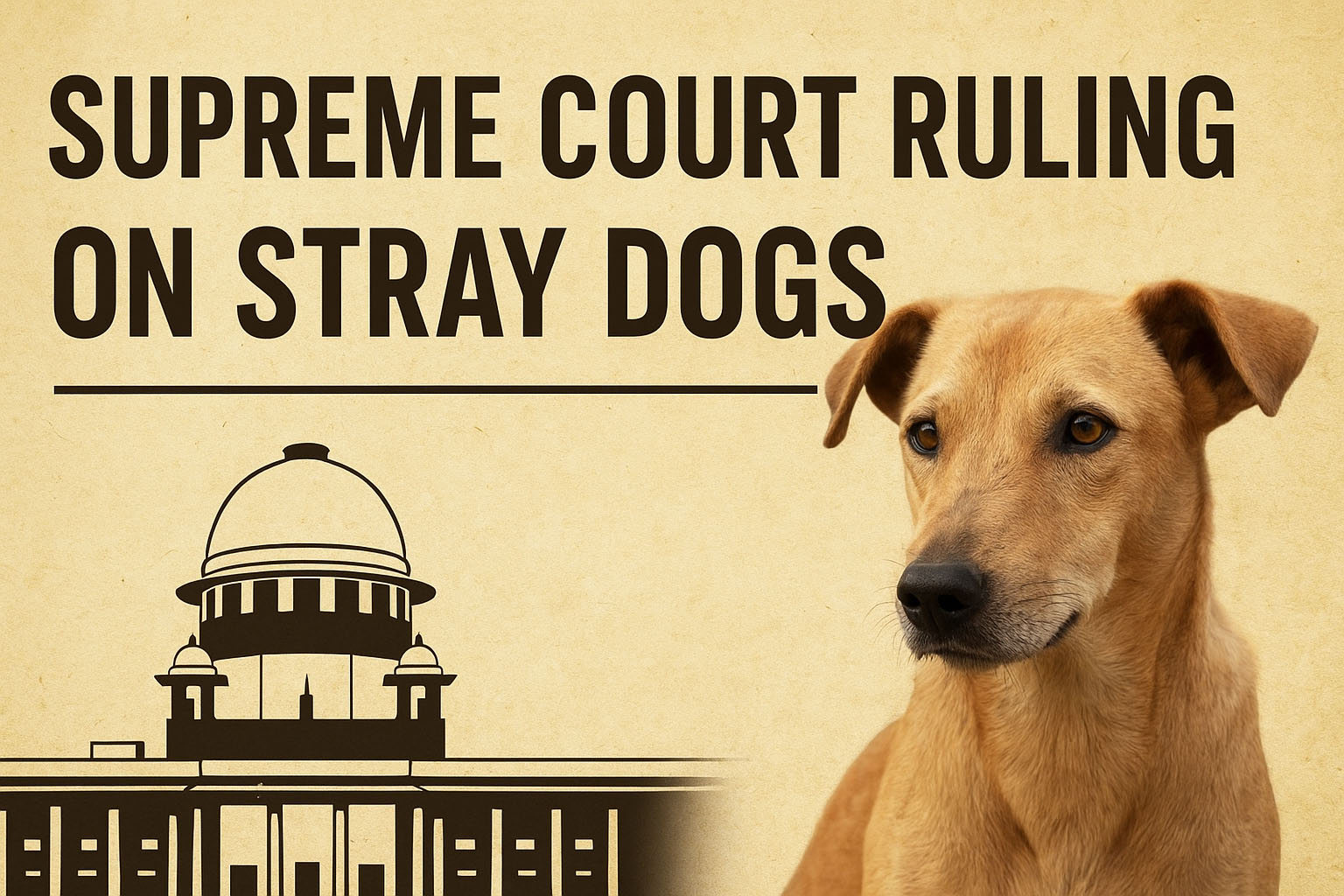🐕 Supreme Court Ruling on Stray Dogs 2025: A Humane and Balanced Approach
India’s Supreme Court modifies its earlier directive on stray dogs, mandating sterilisation, vaccination, and re-release to their original areas, while regulating feeding practices and addressing public safety concerns.
Supreme Court Ruling on Stray Dogs
The Supreme Court of India has recently made a significant statement regarding the rights and responsibilities related to stray dogs, sparking debate across the country. While animal rights activists welcomed the judgment as a step toward compassionate treatment of street dogs, many citizens expressed concern about the rising number of dog bite cases and the safety of children and senior citizens. The ruling highlights the ongoing challenge of balancing human safety with animal welfare in a country where stray dogs are both loved and feared.
What Did the Supreme Court Say?
The Supreme Court observed that stray dogs have a right to food and life under Article 21 of the Indian Constitution, but this right must coexist with the right of citizens to live safely without fear of attacks. The court stated that municipalities, state governments, and residents share a responsibility to manage street dogs humanely without resorting to cruelty or mass culling.
The Court emphasized three main points:
- Right to Feed, But with Responsibility – Citizens and animal lovers can feed stray dogs but must do so in designated areas so that it does not create a nuisance or danger to others.
- Duty of Municipal Authorities – Local bodies must implement sterilization and vaccination programs effectively, as mandated by the Animal Birth Control (ABC) Rules.
- Balance Between Rights – The court stressed that human rights and animal rights must be balanced and neither should override the other.
Why the Supreme Court Ruling on Stray Dogs Matters
The issue of stray dogs in India has long been a subject of debate—balancing animal welfare, public health, and community safety. Recently, the Supreme Court of India issued a landmark ruling that has reshaped the conversation.
Earlier in August 2025, the Court ordered the mass relocation of stray dogs in Delhi-NCR to shelters, sparking widespread criticism from animal rights activists and legal experts. But in a revised ruling on August 22, 2025, a three-judge bench modified the order, aligning it with the Animal Birth Control (ABC) Rules, which mandate sterilisation and re-release.
This ruling not only impacts Delhi-NCR but is expected to influence a national policy on stray dogs in India, making it a historic moment for both citizens and animal welfare groups.
What Was the Supreme Court’s Earlier Order on Stray Dogs?
On August 11, 2025, a two-judge bench of the Supreme Court directed civic authorities in Delhi-NCR to:
- Capture all stray dogs within eight weeks.
- Relocate them permanently to animal shelters.
- Prohibit re-release into the community.
The order stemmed from concerns over dog bites and rabies cases, especially in urban areas. However, it clashed directly with the Animal Birth Control (Dogs) Rules, 2023, which require sterilized and vaccinated dogs to be returned to their original locations.
Animal welfare organizations, including PETA India and People for Animals, immediately voiced concerns, warning that the ruling would overwhelm shelters, violate established law, and risk the ecological balance of local dog populations.
The Revised Supreme Court Ruling (August 22, 2025)
Responding to public outcry and expert petitions, a three-judge bench led by Justices Vikram Nath, Sandeep Mehta, and N. V. Anjaria issued a modified ruling.
Key highlights of the revised order:
- Sterilisation and Release
- Stray dogs must be sterilised and vaccinated.
- After treatment, they must be released back to the same locality where they were captured.
- Exceptions
- Dogs found with rabies must be quarantined and treated.
- Dogs proven to be aggressive or violent may be kept in shelters.
- Feeding Regulations
- Feeding stray dogs in random public areas (parks, roads, colonies) is prohibited.
- Designated feeding zones must be created by municipal authorities.
- National Policy Development
- All similar cases pending in High Courts across India have been transferred to the Supreme Court.
- The Court will now draft a uniform national stray dog policy.
This shift from a mass relocation approach to a scientific, humane, and practical model has been welcomed by animal rights activists, while also addressing citizens’ concerns about safety.
Why the Revised Ruling is Important by Supreme Court Ruling on Stray Dogs
The Supreme Court’s decision represents a balanced approach. It acknowledges the dangers of uncontrolled stray populations while respecting animal rights.
Supreme Court Ruling on Stray Dogs and Benefits of the ruling:
- For Public Safety: Rabid or violent dogs can be isolated, reducing bite cases.
- For Animal Welfare: Dogs are not permanently confined but allowed to live in their community.
- For Law & Policy: Aligns with ABC Rules, preventing contradictory orders.
- For Civic Authorities: Provides a clearer, more manageable framework for stray management.
The Role of the Animal Birth Control (ABC) Rules
The ABC Rules (2023) are the cornerstone of India’s humane dog population management system.
- Sterilisation prevents uncontrolled breeding.
- Vaccination helps control rabies spread.
- Re-release ensures ecological balance—removing dogs entirely would lead to new, unvaccinated dogs occupying the area (“vacuum effect”).
By reaffirming the ABC model, the Supreme Court has validated years of scientific and community-based evidence on stray dog management.
Voices from the Field by the decision of Supreme Court Ruling on Stray Dogs
- Maneka Gandhi, senior BJP leader and animal rights activist, called the judgment a “scientific ruling”, praising its humane nature while urging the Court to clearly define what qualifies as “aggressive” behavior.
- PETA India welcomed the decision, noting that blanket removal would have caused immense suffering and failed to solve the root problem.
- Municipal Corporations have acknowledged the responsibility and are now working to identify feeding zones and expand sterilisation programs.
The Stray Dog Challenge in India and the decision Supreme Court Ruling on Stray Dogs
Stray dogs are a complex issue in India, influenced by multiple factors:
- Unregulated Breeding: Lack of effective sterilization programs leads to uncontrolled growth of dog populations.
- Garbage Mismanagement: Open garbage dumps provide abundant food sources, encouraging stray populations to thrive.
- Weak Implementation of Laws: Although the Animal Welfare Board and various High Courts have issued guidelines, implementation at the local level is inconsistent.
- Rabies Concerns: India accounts for nearly one-third of global rabies deaths, often linked to stray dog bites.
Challenges Ahead on the decision Supreme Court Ruling on Stray Dogs
While the ruling is a positive step, implementation will be the real test.
- Defining Aggression
Without clear criteria, dogs may be wrongly categorised as “aggressive.” - Infrastructure Gap
Many cities lack sufficient shelters, sterilisation facilities, and vaccination programs. - Feeding Regulations
Designated feeding zones must be clearly marked and monitored to prevent disputes between feeders and residents. - Public Awareness
Citizens need education about coexisting with community dogs, avoiding provocation, and reporting rabies cases.
Popular Debate: Public Safety vs Animal Rights. What Makes the decision Supreme Court Ruling on Stray Dogs
The ruling has reignited a larger national debate.
- Public safety advocates argue that stray dog populations pose a danger in high-density urban areas, citing rising bite cases.
- Animal rights groups insist that coexistence, sterilisation, and vaccination are the only sustainable solutions.
The Supreme Court’s decision attempts to bridge this divide by adopting a middle ground.
Implications for a National Stray Dog Policy and the decision of Supreme Court Ruling on Stray Dogs.
With all related cases consolidated under its jurisdiction, the Supreme Court now has the opportunity to push for a uniform national policy.
Key elements may include:
- Nationwide sterilisation drives.
- Central funding for municipal dog control programs.
- Guidelines for handling aggressive and rabid dogs.
- A clear code of conduct for feeding community dogs.
This would standardise stray dog management across India, reducing confusion and conflict at the state level.
A Humane and Practical Way Forward on the decision Supreme Court Ruling on Stray Dogs
The Supreme Court’s ruling on stray dogs in 2025 reflects India’s evolving approach to animal welfare and public health. By modifying its earlier directive, the Court has endorsed a scientific, compassionate, and lawful strategy—sterilisation, vaccination, re-release, and regulated feeding.
This judgment represents not just a legal milestone but also a step towards coexistence between humans and community dogs. The real challenge now lies in execution—ensuring municipal bodies, NGOs, and citizens work together to make the policy effective on the ground.
As India waits for a comprehensive national stray dog policy, this ruling may well set the foundation for a humane, safe, and sustainable future.

